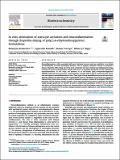| dc.contributor.author | Krukiewicz, Katarzyna | |
| dc.contributor.author | Kowalik, Agnieszka | |
| dc.contributor.author | Turczyn, Roman | |
| dc.contributor.author | Biggs, Manus J. P. | |
| dc.date.accessioned | 2020-04-21T10:29:33Z | |
| dc.date.available | 2020-04-21T10:29:33Z | |
| dc.date.issued | 2020-04-08 | |
| dc.identifier.citation | Krukiewicz, Katarzyna, Kowalik, Agnieszka, Turczyn, Roman, & Biggs, Manus J. P. (2020). In vitro attenuation of astrocyte activation and neuroinflammation through ibuprofen-doping of poly(3,4-ethylenedioxypyrrole) formulations. Bioelectrochemistry, 134, doi:https://doi.org/10.1016/j.bioelechem.2020.107528 | en_IE |
| dc.identifier.issn | 1878-562X | |
| dc.identifier.uri | http://hdl.handle.net/10379/15892 | |
| dc.description.abstract | Neuroinflammation is often associated with poor functional recovery and may contribute to or initiate the development of severe neurological disorders, such as epilepsy, Parkinson's disease or Alzheimer's disease. Ibuprofen (IBU), being one of the most commonly used non-steroidal anti-inflammatory drugs, is known to possess neuroprotective activity and serve as a promising therapeutic for the treatment of neuroinflammation. In this study, the potential of an IBU-loaded poly(3,4-ethylenedioxypyrrole) (PEDOP) matrix has been assessed as a neural interface material with an aim to control astrocyte activation and suppress neuroinflammation in vitro. Three types of drug immobilization protocols were investigated, leading to the fabrication of IBU-loaded PEDOP matrices exhibiting a broad spectrum of electrical characteristics, drug release profiles, as well as biological responses. Among all investigated PEDOP formulations, PEDOP matrices formed through a three-step immobilization protocol exhibited the highest charge storage capacity (30 ± 1 mC/cm2) as well as a double layer capacitance of 645.0 ± 51.1 µF, associated with a relatively enlarged surface area. Demonstrating a total drug loading capacity of 150 µg/ml and a release rate constant of 0.15 1/h, this coating formulation may be employed as a safe electrical conducting drug eluting system. | en_IE |
| dc.description.sponsorship | This publication has emanated from research conducted with the financial support of Science Foundation Ireland and is cofunded under the European Regional Development Fund under Grant Number 13/RC/2073. This project has received funding from the European Union's Horizon 2020 research and innovation programme under the Marie Skłodowska-Curie grant agreement No 713690 and SFI Technology Innovation Development Programme, grant no.15/TIDA/2992. This work has been supported by the Polish National Science Centre in the framework of Sonata 2016/23/D/ST5/01306. The authors acknowledge the facilities and scientific and technical assistance of the Centre for Microscopy & Imaging at the National University of Ireland Galway, a facility that is funded by NUIG and the Irish Government's Programme for Research in Third Level Institutions, Cycles 4 and 5, National Development Plan 2007-2013. | en_IE |
| dc.format | application/pdf | en_IE |
| dc.language.iso | en | en_IE |
| dc.publisher | Elsevier | en_IE |
| dc.relation.ispartof | Bioelectrochemistry | en |
| dc.rights | Attribution-NonCommercial-NoDerivs 3.0 Ireland | |
| dc.rights.uri | https://creativecommons.org/licenses/by-nc-nd/3.0/ie/ | |
| dc.subject | Conducting polymers | en_IE |
| dc.subject | Drug delivery | en_IE |
| dc.subject | Ibuprofen | en_IE |
| dc.subject | Neuroinflammation | en_IE |
| dc.subject | Neural interfaces | en_IE |
| dc.subject | Poly(3,4-ethylenedioxypyrrole) | en_IE |
| dc.title | In vitro attenuation of astrocyte activation and neuroinflammation through ibuprofen-doping of poly(3,4-ethylenedioxypyrrole) formulations | en_IE |
| dc.type | Article | en_IE |
| dc.date.updated | 2020-04-19T19:06:39Z | |
| dc.identifier.doi | 10.1016/j.bioelechem.2020.107528 | |
| dc.local.publishedsource | https://doi.org/10.1016/j.bioelechem.2020.107528 | en_IE |
| dc.description.peer-reviewed | peer-reviewed | |
| dc.contributor.funder | Science Foundation Ireland | en_IE |
| dc.contributor.funder | European Regional Development Fund | en_IE |
| dc.contributor.funder | Horizon 2020 | en_IE |
| dc.internal.rssid | 20653941 | |
| dc.local.contact | Katarzyna Krukiewicz. Email: katarzyna.krukiewicz@nuigalway.ie | |
| dc.local.copyrightchecked | Yes, covered by the agreement between Elsevier and the Silesian University of Technology, Gliwice, Poland. Therefore, gold open access is provided (email from KK on 20/04/2020). | |
| dc.local.version | PUBLISHED | |
| dcterms.project | info:eu-repo/grantAgreement/SFI/SFI Research Centres/13/RC/2073/IE/C�RAM - Centre for Research in Medical Devices/ | en_IE |
| dcterms.project | info:eu-repo/grantAgreement/EC/H2020::MSCA-COFUND-FP/713690/EU/Career Development and Mobility Fellowships in Medical Device Research and Development: A CÚRAM Industry-Academia Training Initiative./MedTrain | en_IE |
| dcterms.project | info:eu-repo/grantAgreement/SFI/SFI Technology and Innovation Development Award (TIDA)/15/TIDA/2992/IE/Biomimetic electrically conducting polymer scaffolds as novel neuromodulatory neuroelectrodes for the treatment of chronic pain/ | en_IE |
| nui.item.downloads | 272 | |


